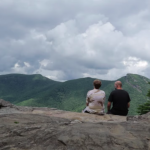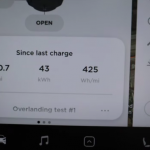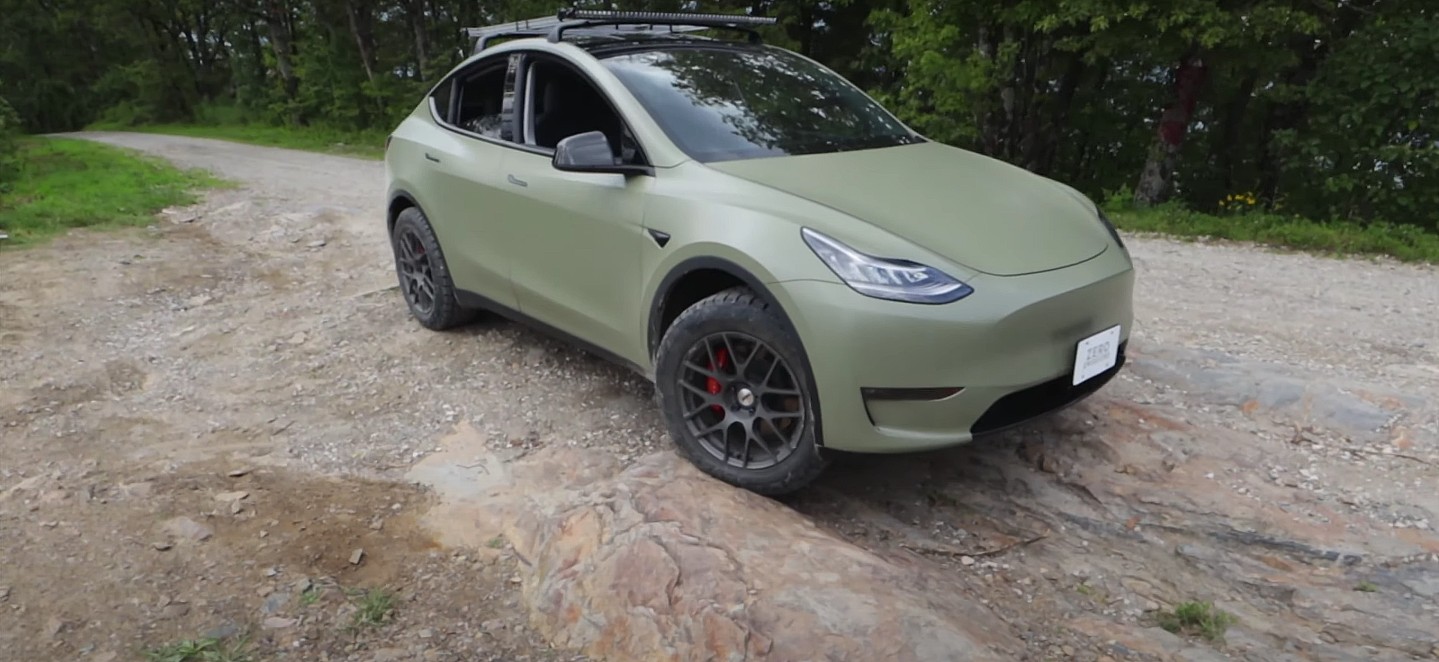
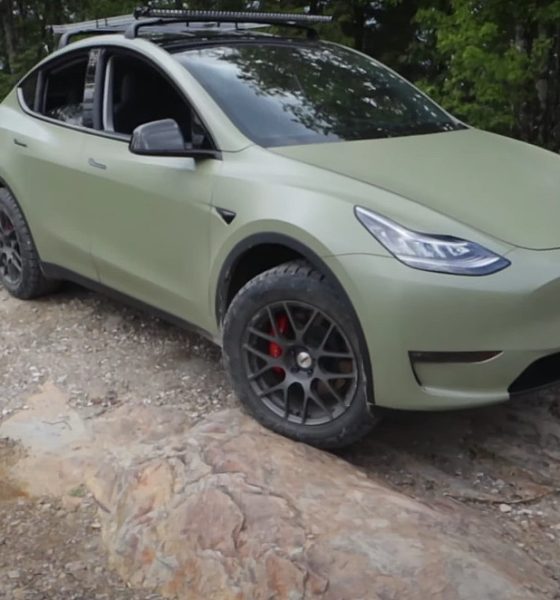
News
Tesla owner lifts Model Y in wicked off-road conversion
The Tesla Model Y is a quick and sleek crossover powered by an all-electric, but that doesn’t mean that the vehicle can’t handle rough and rugged trails in the mountains with the help of a lifted suspension and the company’s “Off-Road Assist” feature.
Brian Jenkins of the i1Tesla YouTube channel took his Model Y Performance into the North Carolina mountains to see if Tesla’s newest vehicle could handle the challenging terrain. Jenkins has made several modifications to his Model Y, which he refers to as the “Overlanding Build,” that would encourage the car to perform adequately in an off-road setting.
Jenkins installed a 4-inch suspension lift from Mountain Pass Performance to increase ground clearance, All-Season Toyo A/T III tires, aftermarket rims from TSW, and an Earthy-themed combat green wrap to his Model Y. With these modifications, he was ready to assess the capabilities of his electric crossover in a terrain.
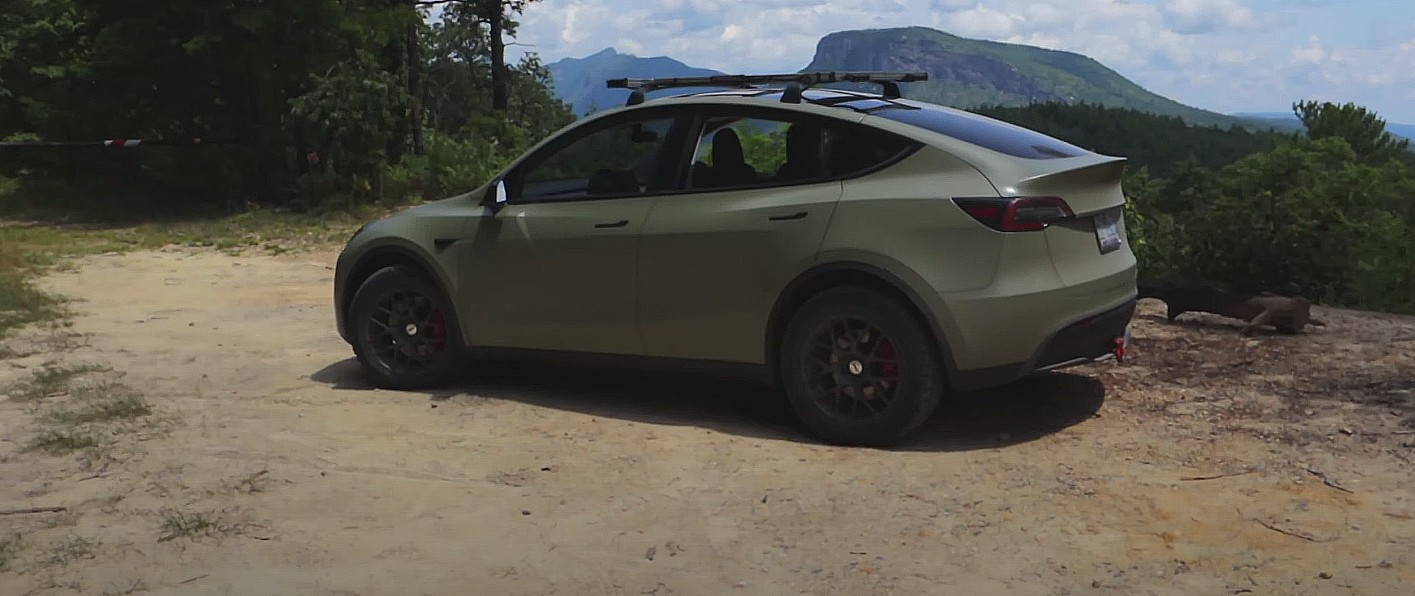
Jenkins used 31-inch all-terrain tires from Toyo for increased confidence when maneuvering through the tough trails of the mountains. “These are probably the biggest tires you can put on a Tesla,” he said.
He also elaborated that the vehicle is not necessarily geared for off-roading, but more of an Overlanding style of driving. Overlanding describes a trip that requires traveling to remote destinations where journeying is the primary goal. Jenkins believes that the purpose of Overlanding captures his vehicle’s essence perfectly.
“That is what the Tesla is all about as far as going on trips. What better way to go off-road or into the wilderness than with a zero-emissions vehicle. Enjoy the adventure!”
To help the cause and test some of the Model Y’s unique features, Jenkins activated Tesla’s “Off-Road Assist” functionality, which improves traction and helps with overall improvements when driving on tricky terrains. The feature also works to balance the torque between and front and rear motors, which also increases traction during operation.
The Overlanding-geared Model Y encountered many tests during its session of driving. Steep hills covered with small rocks and small gullies that have damaged roadways were among the first terrain challenges that the all-electric crossover faced.
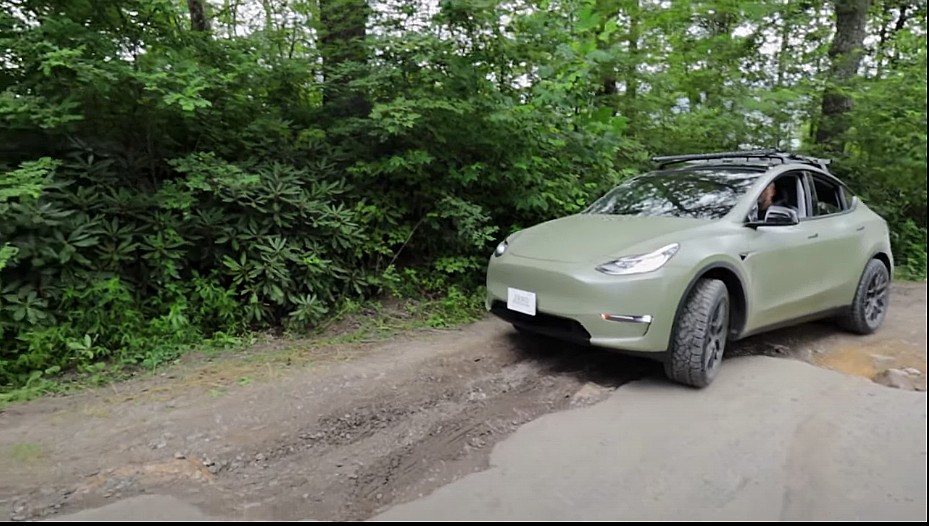
The steep terrain, nor the gulley managed to provide any challenges for Jenkins’ Model Y, as the vehicle was able to handle the deep divots in the road and the small rocks. Thanks to the upgrades that Jenkins made, combined with the confidence that the Off-Road assist feature provides, there was no issue with the electric car making its way through the problematic settings that it encountered.
Ultimately, Jenkins and his Tesla Model Y were able to climb the 3,400-foot mountain and reach the top. Along the way, the Model Y burned 38% battery, starting at 90% and reaching the peak at 52%. Thanks to Tesla’s regenerative braking system, the Model Y lost only 3% during the journey down the mountain.
- Jenkins and his son after conquering the 2,900-foot ascension up the North Carolina mountains. (Credit: YouTube | i1Tesla)
- The energy usage during Jenkins’ Model Y trip up the North Carolina mountains. (Credit: YouTube | i1Tesla)
The total trip was 100.7 miles, and the Model Y used 43 kWh of energy during its 3,800-foot journey up and back down of the North Carolina mountains.
The Model Y was geared toward offering a sustainable crossover SUV from Tesla that would take a chunk out of the most popular vehicle segment in the United States. However, it is more than a grocery getter or a car to take the kids to soccer practice because it is capable of handling tough off-road terrain with relative ease. The test from Jenkins shows the all-electric crossover can handle difficult stretches of road, while still offering efficiency and world-class performance.
Watch Jenkins’ full Model Y climb in the mountains of North Carolina below.

News
Tesla aims to combat common Full Self-Driving problem with new patent
Tesla writes in the patent that its autonomous and semi-autonomous vehicles are heavily reliant on camera systems to navigate and interact with their environment.

Tesla is aiming to combat a common Full Self-Driving problem with a new patent.
One issue with Tesla’s vision-based approach is that sunlight glare can become a troublesome element of everyday travel. Full Self-Driving is certainly an amazing technology, but there are still things Tesla is aiming to figure out with its development.
Unfortunately, it is extremely difficult to get around this issue, and even humans need ways to combat it when they’re driving, as we commonly use sunglasses or sun visors to give us better visibility.
Cameras obviously do not have these ways to fight sunglare, but a new patent Tesla recently had published aims to fight this through a “glare shield.”
Tesla writes in the patent that its autonomous and semi-autonomous vehicles are heavily reliant on camera systems to navigate and interact with their environment.

The ability to see surroundings is crucial for accurate performance, and glare is one element of interference that has yet to be confronted.
Tesla described the patent, which will utilize “a textured surface composed of an array of micro-cones, or cone-shaped formations, which serve to scatter incident light in various directions, thereby reducing glare and improving camera vision.”

The patent was first spotted by Not a Tesla App.
The design of the micro-cones is the first element of the puzzle to fight the excess glare. The patent says they are “optimized in size, angle, and orientation to minimize Total Hemispherical Reflectance (THR) and reflection penalty, enhancing the camera’s ability to accurately interpret visual data.”
Additionally, there is an electromechanical system for dynamic orientation adjustment, which will allow the micro-cones to move based on the angle of external light sources.
This is not the only thing Tesla is mulling to resolve issues with sunlight glare, as it has also worked on two other ways to combat the problem. One thing the company has discussed is a direct photon count.
CEO Elon Musk said during the Q2 Earnings Call:
“We use an approach which is direct photon count. When you see a processed image, so the image that goes from the sort of photon counter — the silicon photon counter — that then goes through a digital signal processor or image signal processor, that’s normally what happens. And then the image that you see looks all washed out, because if you point the camera at the sun, the post-processing of the photon counting washes things out.”
Future Hardware iterations, like Hardware 5 and Hardware 6, could also integrate better solutions for the sunglare issue, such as neutral density filters or heated lenses, aiming to solve glare more effectively.
Elon Musk
Delaware Supreme Court reinstates Elon Musk’s 2018 Tesla CEO pay package
The unanimous decision criticized the prior total rescission as “improper and inequitable,” arguing that it left Musk uncompensated for six years of transformative leadership at Tesla.

The Delaware Supreme Court has overturned a lower court ruling, reinstating Elon Musk’s 2018 compensation package originally valued at $56 billion but now worth approximately $139 billion due to Tesla’s soaring stock price.
The unanimous decision criticized the prior total rescission as “improper and inequitable,” arguing that it left Musk uncompensated for six years of transformative leadership at Tesla. Musk quickly celebrated the outcome on X, stating that he felt “vindicated.” He also shared his gratitude to TSLA shareholders.
Delaware Supreme Court makes a decision
In a 49-page ruling Friday, the Delaware Supreme Court reversed Chancellor Kathaleen McCormick’s 2024 decision that voided the 2018 package over alleged board conflicts and inadequate shareholder disclosures. The high court acknowledged varying views on liability but agreed rescission was excessive, stating it “leaves Musk uncompensated for his time and efforts over a period of six years.”
The 2018 plan granted Musk options on about 304 million shares upon hitting aggressive milestones, all of which were achieved ahead of time. Shareholders overwhelmingly approved it initially in 2018 and ratified it once again in 2024 after the Delaware lower court struck it down. The case against Musk’s 2018 pay package was filed by plaintiff Richard Tornetta, who held just nine shares when the compensation plan was approved.
A hard-fought victory
As noted in a Reuters report, Tesla’s win avoids a potential $26 billion earnings hit from replacing the award at current prices. Tesla, now Texas-incorporated, had hedged with interim plans, including a November 2025 shareholder-approved package potentially worth $878 billion tied to Robotaxi and Optimus goals and other extremely aggressive operational milestones.
The saga surrounding Elon Musk’s 2018 pay package ultimately damaged Delaware’s corporate appeal, prompting a number of high-profile firms, such as Dropbox, Roblox, Trade Desk, and Coinbase, to follow Tesla’s exodus out of the state. What added more fuel to the issue was the fact that Tornetta’s legal team, following the lower court’s 2024 decision, demanded a fee request of more than $5.1 billion worth of TSLA stock, which was equal to an hourly rate of over $200,000.
Delaware Supreme Court Elon Musk 2018 Pay Package by Simon Alvarez
News
Tesla Cybercab tests are going on overdrive with production-ready units
Tesla is ramping its real-world tests of the Cybercab, with multiple sightings of the vehicle being reported across social media this week.

Tesla is ramping its real-world tests of the Cybercab, with multiple sightings of the autonomous two-seater being reported across social media this week. Based on videos of the vehicle that have been shared online, it appears that Cybercab tests are underway across multiple states.
Recent Cybercab sightings
Reports of Cybercab tests have ramped this week, with a vehicle that looked like a production-ready prototype being spotted at Apple’s Visitor Center in California. The vehicle in this sighting was interesting as it was equipped with a steering wheel. The vehicle also featured some changes to the design of its brake lights.
The Cybercab was also filmed testing at the Fremont factory’s test track, which also seemed to involve a vehicle that looked production-ready. This also seemed to be the case for a Cybercab that was spotted in Austin, Texas, which happened to be undergoing real-world tests. Overall, these sightings suggest that Cybercab testing is fully underway, and the vehicle is really moving towards production.
Production design all but finalized?
Recently, a near-production-ready Cybercab was showcased at Tesla’s Santana Row showroom in San Jose. The vehicle was equipped with frameless windows, dual windshield wipers, powered butterfly door struts, an extended front splitter, an updated lightbar, new wheel covers, and a license plate bracket. Interior updates include redesigned dash/door panels, refined seats with center cupholders, updated carpet, and what appeared to be improved legroom.
There seems to be a pretty good chance that the Cybercab’s design has been all but finalized, at least considering Elon Musk’s comments at the 2025 Annual Shareholder Meeting. During the event, Musk confirmed that the vehicle will enter production around April 2026, and its production targets will be quite ambitious.
